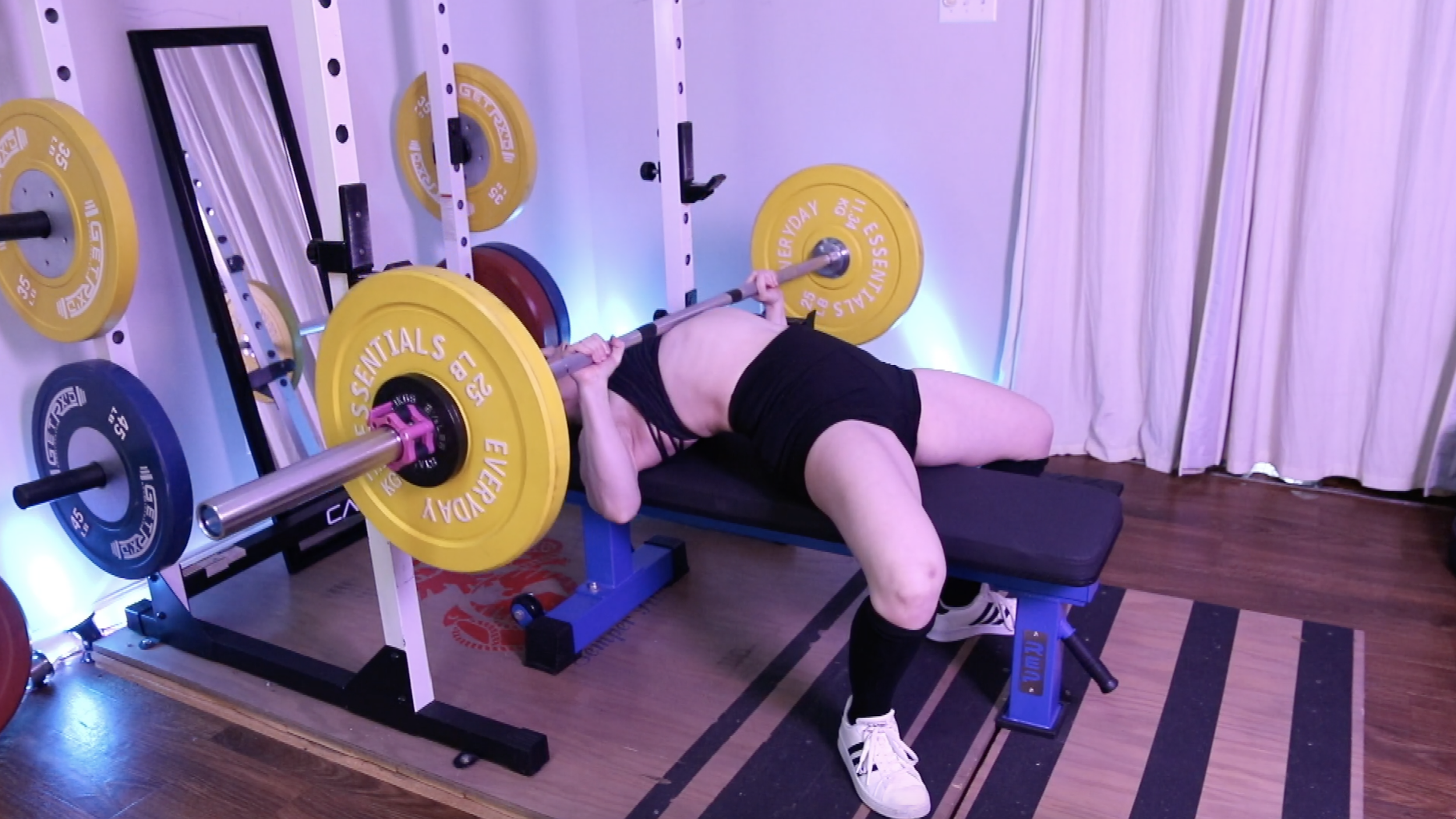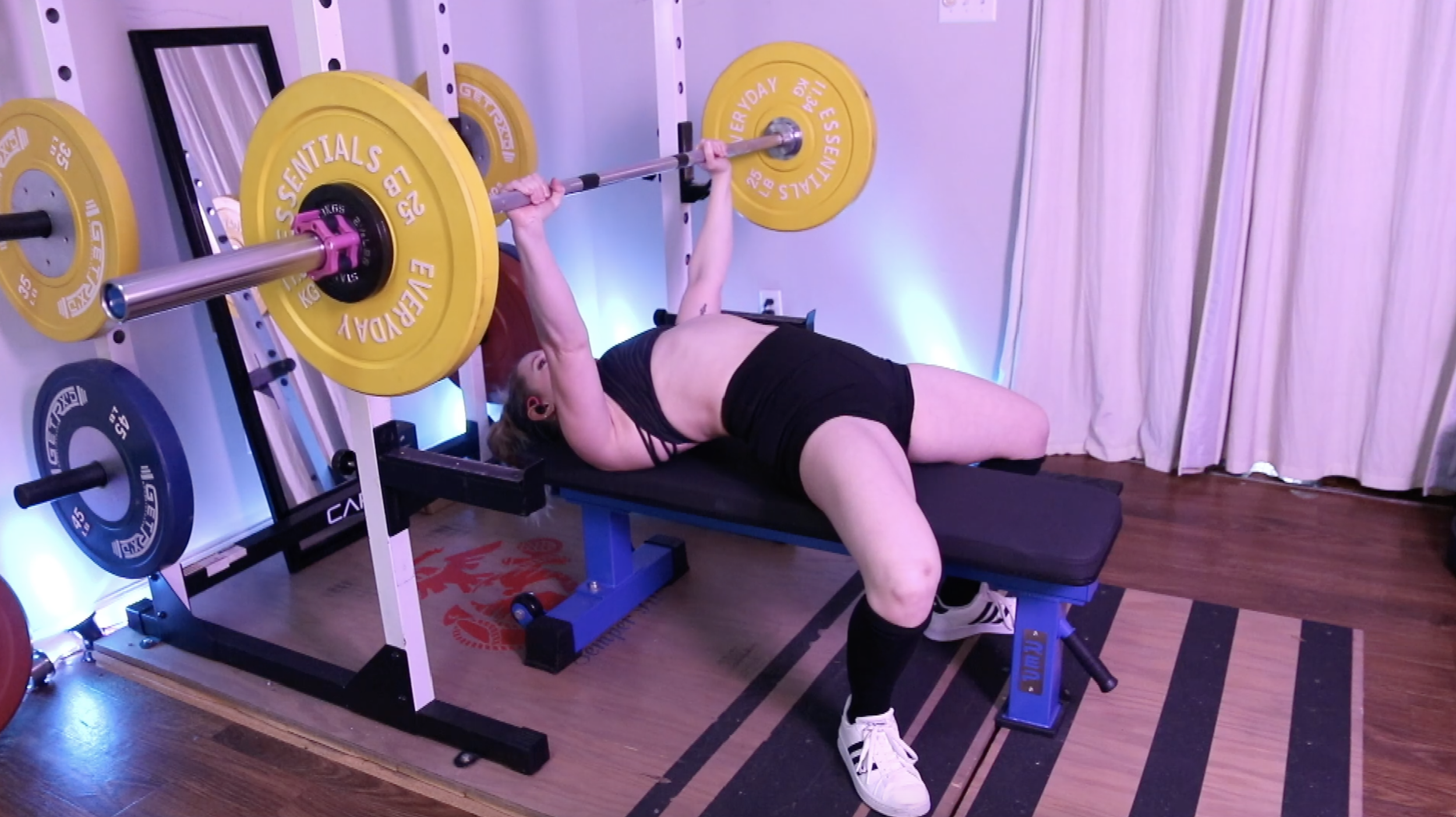Technique Tips for Bench Press
If you want a strong upper body, bench press is one of the best exercises to train. This compound exercise targets multiple muscle groups, including the pecs, delts, and triceps as well as stabilizing muscles throughout your core and legs.
Bench press is one of the most fun and rewarding exercises to train your upper body. There’s just something about this lift that makes me feel so powerful!
Bench press (or “bench” for short) is one of the cornerstone lifts of weight training. It involves laying face-up on a bench and lowering a barbell towards your chest before pushing it back up above your shoulders.
Let’s talk about how to perform the bench press with good technique to minimize injury and maximize gains.
Equipment Setup
If you’re benching at a squat rack or stand, set your bench between the rack so that one end is in the middle between the steel tubes (if you’re using an olympic bench, the bench is already secured to the rack).
Set the J Hooks to the height of where your hands reach when laying flat on the bench face-up with your elbows bent.
Make sure to also set up the safeties to just below the level that the bar sits at the bottom of the exercise.
Place the bar in the J Hooks and adjust the bench if needed. Load up the bar with any plates you may be using and secure the plates with a plate collar on each side (if you’re warming up, I recommend starting with no weights on the bar for at least one set; add weight gradually to work your way up to your working set weight).
Bench Press Technique
Once your equipment is set up, you’re ready to get your body into position to perform the exercise. If this is your first time performing the bench press, begin with just the bar and master the technique before adding more weight.
Lay down on the bench face-up with your feet on the floor. Position yourself so that the bar is right over your eyes. Bring your feet close to under your knees so that you can drive your feet firmly into the ground.
Reach up and grip the bar with your hands, using either your thumbs or your pinkies against the bar’s knurling to ensure that they’re spaced evenly (see Notes below about hand positioning for narrow, wide, and medium grip).
Make your whole body rigid and engaged so that you can stabilize while performing the exercise:
Engage your back muscles as you drive your shoulders into the bench and push your chest up towards the ceiling.
Engage your glutes and quads to drive your legs toward the floor to stabilize your lower body.
Inhale and brace by engaging your abdominals and other core muscles while you hold the air in your belly.
Unrack the weight and bring the bar just over your shoulders. Take another optional breath and stay braced.
Keep the tension in your body as you bend your elbows and lower the bar down toward the middle/lower part of your sternum. Stop when the bar is touching your sternum.
Continue to keep the tension throughout your body as you push the bar back up toward the ceiling and let it rest just above your shoulders. You have just completed 1 rep. Take a shallow breath, keeping tension in your body before re-bracing and performing another rep.
Continue for the recommended number of reps in your training program before re-racking the weight on the J Hooks and relaxing.
Some Notes
HAND POSITIONING
There are 3 main styles of hand positioning on the bar—each emphasizing different muscles.
Wide Grip: hands are wider than shoulder-width apart on the bar, emphasizing the pecs (chest muscles) and possibly allowing a heavier load as it shortens the distance the bar has to travel.
Medium Grip: hands are about shoulder-width on the bar, with shared emphasis between the pecs and triceps. This is a good place to start if you’re learning how to bench press.
Narrow Grip: hands are closer than shoulder-width apart on the bar, placing more emphasis on the triceps. This variation is good to practice to develop a strong lockout, however you won’t be able to lift as heavy as with a wide grip. If you experience pain in your elbows, consider lowering the weight or wearing elbow sleeves.
BAR PATH
To make your bench press more efficient, pay attention to the bar path—that is the line that shows how a barbell moves during the exercise.
Many beginners mistakenly think that the bar should move straight up and down in a vertical line during this exercise. But the truth is that the bar travels both horizontally and vertically between the descent and ascent.
On the descent, the bar travels in a diagonal arc beginning from just above the shoulders to above the mid- or lower sternum at the bottom. This bar path is fairly consistent between novice, intermediate, and elite lifters, as Greg Nuckels writes.
On the ascent, the most efficient bar path is to pull the bar back toward the shoulders before pressing the bar nearly vertically back up to the starting position (see the graph below).
LEG DRIVE
One of the most important parts of a strong bench press is using your legs to push your back into the bench. This is called “leg drive,” and it creates stability throughout your whole body while you perform the movement.
The best position to generate leg drive is to place your feet slightly outside of hip width and under your knees, keeping your ankles just under your knees and your feet flat on the ground.
Then push through your toes and drive your feet into the ground while engaging your quads, as if trying to do a leg extension. Use that force to drive your shoulders further into the bench as you pinch your shoulder blades (scapula) together and down. Keep this tension throughout the entire range of motion.
Avoid tucking your feet back too far, which can overextend the spine, leading to lower back cramps during a hard rep and inefficient leg drive that causes the hips to shoot up off the bench (which will get you an automatic red light in competition).
BACK ARCH
As you drive your shoulders down into the bench, this will result in a slight arch in your back. This position creates more shoulder stability, allows you to engage your pecs more, and allows the force generated by your leg drive to transfer more efficiently to the bar. It also reduces the range of motion (that is, the distance that the bar has to travel)—which allows you to lift more weight.
Technique Reviews on Twitch
Join me live on my Twitch channel on Tuesdays for Technique Reviews! I go into further detail on different exercise techniques and review examples from members of the community. If you’d like some feedback on your exercise form, make sure to:
Join my Coaching Corner Discord server and follow me on Twitch
Subscribe to the Coaching Corner Discord as a Supporter or Supporter+
In the Coaching Corner Discord server, choose the “Workouts &. Fitness” role in the #choose-roles channel
Post your exercise videos to the #technique-reviews channel each week to get reviewed while I’m live on Twitch
Watch the video below to watch my demonstration of bench press technique while I was live on my Twitch channel:
Sign up for updates ✉️
Sign up for more exercise tips and get notified whenever I post to the Training Blog. Fill out the form below:
Your privacy is important to me! I will never share your information with any third party. Unsubscribe from the email list at any time.
About the Author
Jayd Harrison (aka Jaydigains) is a health coach, personal trainer, and host of the Coaching Corner Podcast. She helps people build muscle, burn fat, and clean up their diets with her online coaching programs and other online content. Check out some of Jayd’s coaching videos on Youtube, or join Jayd live on Twitch and follow on social media.






